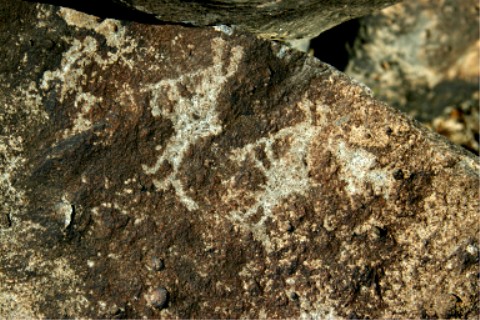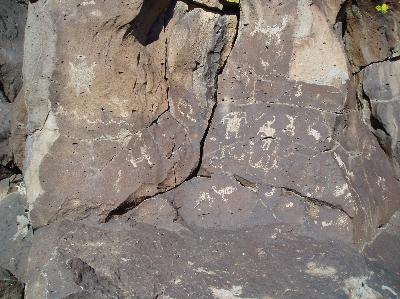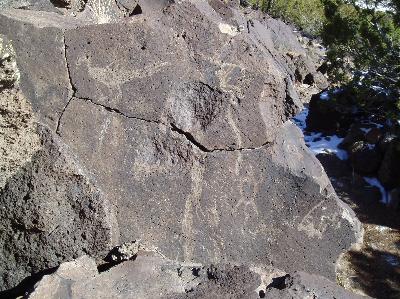
Photo Gallery
The Photo Gallery is meant to provide a way for Stewards to show case the archaeology of the Forest. Areas outside the bounds of the Forest will be considered based upon their relation to the Forest. It is with this latter criteria our first offering is made. Like the Newsletter previous offerings will be kept available.
Cieneguilla Rock Art
This is just part of the Rock Art along the Santa Fe River Canyon. Some is on PRIVATE property, the rest is on BLM and Forest land.
On a cold windy 4th of December a few Site Stewards waited for the rest to gather in the parking lot of the Blue Corn Cafe. The sky was a dreary gray and it looked like a storm was about to hit. We, on the other hand, did not care. Why you ask would we be out on a day like this? The answer is easy. Terry was going to show this intrepid group his version of a World Class Rock Art site.
After an appropriate wait we set off for the Cieneguilla Rock Art Site. Part of the site overlooks Ceineguilla Pueblo. All of the site is on the southerly side of the volcanic escarpment that forms the Caja del Rio Plateau and over looks the Sante Fe River. As we started the hike in from where we parked our cars, Terry said that he could imagine what it looked like when the river was a bosque. It was easy to look back out over the valley and watershed and see the willow, cotton woods, cattails, and other raparian plants. With just a little more imagination you could see the smoke from the cooking fires of the Pueblos. From the top of the escarpment, there is a clear view into the Galisteo Basin.

The Intrepid Few: Terry, Jan, and Lee
One of the appreciations I have gained from Rock Art is the "feel" of the landscape. All the Rock Art I have seen has a sense of place. Part of its "meaning" is its location. On this cold windy day we were sheltered from the cold wind by the escarpment. We were warmed by the rays of the sun. Many of the concentrations of images were found in alcoves that seemed to trap the warmth more. Is it possible that the creation of Rock Art happened while the earlth slept and the stories were told?

A View Towards Santa Fe and the Snow Clad Sangre de Cristo Mountians
Water is the life force of the arid Southwest. The ethnography of the people tell us over and over how much of their efforts were devoted to rituals that "insured" an adequate supply. Is it an accident that snow collects in the "bowl" of this bolder with images? It was serendipity that allowed us to see this.

Boulder with Snow Filled Bowl and Images
One of the issues we always need to keep in mind with Rock Art Sites is that many are still important to the decendants those who created them and still visit them. In Voices from a Sacred Place, Philip Lauriano says, "The petroglyphs are the nerve center of the Pueblo culture, religion and tradition. They are there to guard, to protect, to teach, to advise, to doctor, to cure".
With this in mind I will share some of the images we saw:

Look at the quadruped to the left of the hand

Lazy Flute Player

Everything is Connected to the Man

Long Legged Quadrupeds. Nine Mile Canyon in Utah has the Long Necked Ones

Quadrupeds Appear to be Playing
Bird has a Snake like Head

Horned Serpent Gathering

Mask on the Edge of the Boulder
©2006 ghein. All Rights Reserved
Terry's views of the Rock Art







©2006 Terry Ballone. All Rights Reserved
Lee's views of the Rock Art









©2006 Lee Borduin. All Rights Reserved